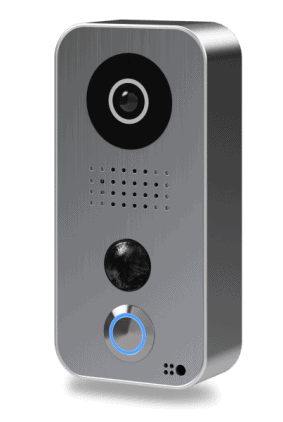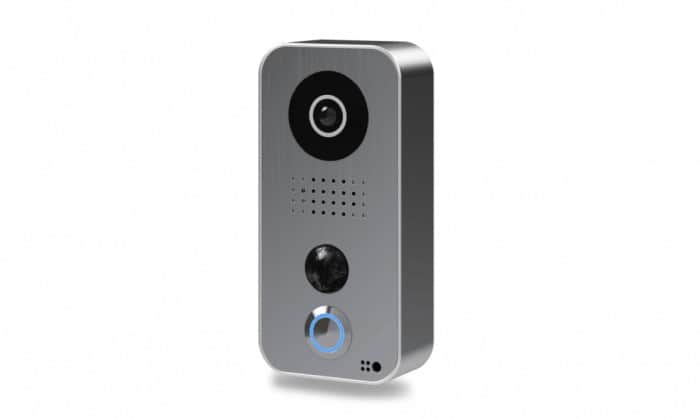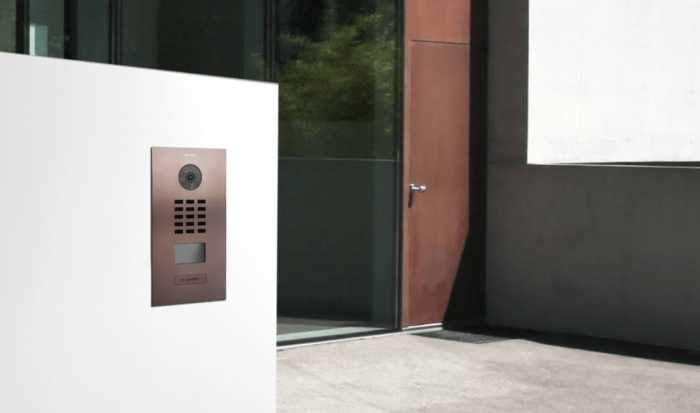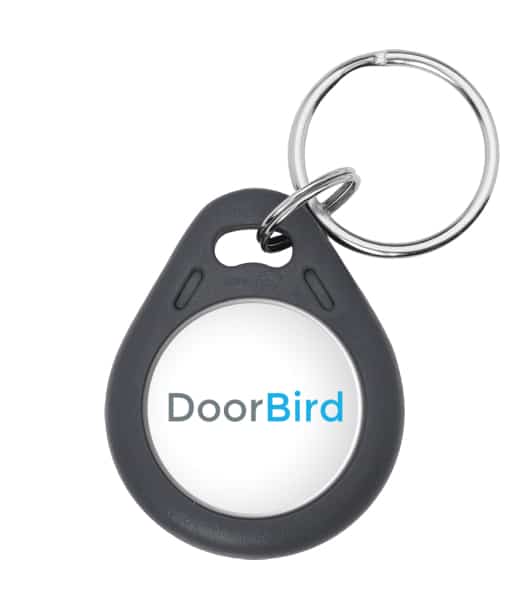DoorBird Review
A robust video intercom system with customizable features


SafeHome.org may receive compensation from some providers listed on this page. Learn More
We may receive compensation from some providers listed on this page. Learn More
A robust video intercom system with customizable features


We recently put DoorBird doorbell cameras through our rigorous testing process. We’ve tried these high-tech devices in the past, but they’ve just added loads of new options to their lineup. What did we find? Well, we found that DoorBird soars above the competition when it comes to quality of build and customizable features. But you should know that it doesn’t come cheap.
Also, whatever you do, don’t call it a “doorbell camera.” DoorBird prefers the term “door station.” It makes sense, seeing that this brand offers powerful IP technology1 and geofencing, remote door opening, and two-way talk. But remember, these products are more expensive (by a long shot) than all other entryway systems we’ve seen. So they are not for the faint-of-heart.
Did You Know? DoorBird door stations are built with precious metals, not cheap plastic. From what we’ve seen, these products are built to last.
With that said, if you’re specifically looking for a robust video intercom system, then you’ll definitely want to read all about DoorBird. We thoroughly researched and tested these door stations. And we’re sharing everything you need to know, right here. So let’s dive right in!
The company behind DoorBird, Bird Home Automation GmbH, started back in 2004 by developing its own IP Video software. The Berlin-based company later released its first door stations in 2009.
Over the years, DoorBird steadily built a portfolio of intercom and video monitoring solutions for doors and entryways. They started with traditional-looking intercoms with a built-in camera, but eventually, they managed to winnow down the size of their products to compete with sleeker-looking products from the video doorbell space. Today, DoorBird is sold in over 160 countries across the globe.
It’s important to note that DoorBird’s equipment is built in Germany. And honestly, the look and feel of the door stations does give off that German engineering vibe. Another consideration is that DoorBird offers a few residential door stations, but they mainly focus on commercial sales and outfitting large buildings with entryway protection. It’s where the money’s at! Overall, we do think this award-winning company2 is worth a closer look.
Check out more recommendations from the SafeHome team:




Doorbird Camera
DoorBird offers 13 different IP video door stations that start at $384 and range all the way up to (gasp) $2,500. To be fair, if you own a single-family home and just want entryway protection, you wouldn’t even consider their high-end products. The base model would do you just fine. But to get a sense of just how steep the prices are — DoorBird’s cheapest doorbell camera is about the same price as Ring’s most expensive doorbell, the Video Doorbell Elite.
Did You Know? The premium DoorBird door stations can offer entryway protection on up to 100 units for multi-tenant buildings.
The D101 and D101S are DoorBird’s most popular residential door stations. For these base models, you can expect to pay $384 and $416 respectively. Compared to our top three doorbell cameras — DoorBird weighs in at twice the cost.
But then again, the other guys don’t offer the same German build quality as DoorBird… or automatic door/gate opening… or protection for multi-unit housing. You have to remember, these are full-on video intercom stations, not just doorbells. Also, you won’t have to worry about monthly fees, activation fees, or any other hidden fees. You just pay for the device and $19 for shipping… and that’s that!
Note that each device comes with free basic cloud storage that stores your 50 most recent doorway visits (accessed via the DoorBird app). But if you do want premium cloud-based storage, you can upgrade to the Cloud-Recording Pro plan, which costs $48 per year.
That’s not so bad, considering that a Ring cloud storage plan costs $3 per month or $30 per year. DoorBird’s cloud pricing is even cheaper than Nest’s $6 per month Nest Aware plan, although that can cover all your Nest cameras and doorbells, whereas DoorBird covers just one door station.
| Cloud Recording Free | Cloud Recording Pro | |
|---|---|---|
| Format | VGA-Images (motion-triggered images) | HD-Videos |
| Storage | 50 most recent visits | 7-day history |
| Price | Free | $48 per year |
We found that patience is a virtue when shopping for DoorBird. The company sells 13 different door stations, and they don’t separate them by category. So it was a bit tricky to distinguish between the residential products and the multi-tenant devices. And the cryptic product names — like D101 or D2101KV — certainly didn’t help. Thankfully, DoorBird links a “data sheet” beneath each product, which allowed us to readily see the features and specs.
We went with a mid-level DoorBird door station, paid our $19 for shipping, and we were told it would take 4 business days to arrive. Not bad at all. The checkout process was really quite simple — but if you get overwhelmed easily, you’re probably not going to like it.
FYI: The DoorBird website offers categories for Door Stations, Indoor Stations, Accessories, Housing/Panels, Call Buttons, Add-On Cameras, Cloud Services, and the list goes on. So be sure to take a few deep breaths and try not to get overwhelmed!
We were expecting the installation to be more difficult than it was. DoorBird’s video doorbells come in hardwired and Power-Over-Ethernet (PoE) options.3 This is different from many of the wireless, battery-powered doorbell cams we’ve tested. But we like different.
Besides, a wired intercom system is going to be much more reliable compared to wireless video doorbells. You don’t have to take down and recharge DoorBird (thankfully, because installing it takes longer than a few minutes!) and if you spring for a PoE option, you’ll get much smoother data transfer for two-way audio and one-way video.
We got a hardwired version, unfortunately, which means we still connected it to Wi-Fi. Luckily, we have good Wi-Fi coverage throughout our property, so keeping the DoorBird connected to the internet wasn’t a problem at all.
All things considered, it was relatively easy to install, and it only took about 15 minutes from start to finish. It uses your existing doorbell wiring, so even though it’s more involved than its plug-and-play competitors, you don’t need to channel Bob Vila to install DoorBird.
That said, a few tools may have to be involved. Some DoorBird models, including the ones we got, sit flush to the wall, so you may have to break out some power tools to get it installed.
Once everything is ready, you activate it by scanning the QR code with a mobile device. The installation wasn’t as easy as wireless options from August or SimpliSafe, but it was simple enough.

Installed Doorbird doorbell
Using DoorBird day-to-day is similar to using other doorbell cameras. Everything is controlled via the DoorBird app, which is well-designed and quite intuitive. We received instant activity alerts when someone approached our front door, and we were able to open the app for live video streaming.
Our model only offered 720p HD resolution, which we didn’t love. The images were grainy, especially in low-light conditions, and they were of little use in identifying details from further away (like the license plate of our neighborhood serial speeder). Still, in the best case scenario – when the subject is standing right in front of our door – the DoorBird door station delivers quality video.
FYI: With DoorBird, you’ll have to spend $500+ to get 1080p HD resolution, while top competitors offer it for around $200.
It was the build quality of DoorBird that really impressed us. These door stations are made with high-grade materials, like precious metals, stainless steel faceplates, and polycarbonate housing. So we get the impression the equipment is built to last. Not that other doorbell brands such as Ring offer products that easily break – they’re usually made of tough plastic – but DoorBird is in a league of its own.
Also, depending on the device you choose, you can get fancy features like geofencing — which allows for hands-free locking/unlocking of your door — and even automatic front gate opening — which is perfect for folks who live on a sprawling estate. Château Lafite, anyone?
You’ll want to consider two things when it comes to customer service. First, DoorBird offers fairly limited customer service options. We were able to access their support portal for self-service, submit a support ticket (which we don’t recommend), or call the company directly. At the risk of sounding old fashioned, we like to speak with real humans, so we called in.
Note that while DoorBird is headquartered in Germany, they have offices in San Francisco. Their stateside office hours are from 9am to 5pm PST, Monday through Friday. That’s right, no weekend hours, which is a definite drawback. But once you get an agent on the line, they really know their stuff!
Did You Know? Unlike many brands we’ve tested, DoorBird is laser-focused on only making door stations, so you’re sure to get someone who can help.
In our experience, this is the hallmark of DoorBird. The top-grade metals, sleek design, and the feeling that it can withstand even the harshest weather conditions. We think the design is second-to-none. You can also customize the color of your faceplate.
The easy-to-use DoorBird app allows you to get motion-activated alerts, view live video footage, and communicate with visitors using your smartphone. Does it stand out in any particular way? Not in our opinion, but you get a solid, reliable app. In our experience testing video doorbell apps since the early days of the Ring video doorbell, that’s something you don’t get from just any company.
This is another way of saying that DoorBird offers two-way talk, allowing you to speak with delivery drivers at your door, from anywhere in the world. Just open the app and let them know where to leave the package. If needed, you can also say a few choice words to porch pirates.
That said, DoorBird does not detect packages using A.I., unlike the Arlo Essential Video Doorbell or the Google Nest Doorbell. Those may cost less than the DoorBird, but they are smart enough to know and tell you when a package is left at your door.
Depending on the door station you choose, you can have full-on video and audio calls with your visitors. Of course, you can do that with any video doorbell, but DoorBird’s wired design makes it more reliable. You can still experience lag or choppy conversations, but in our experience, as long as your Wi-Fi connection is strong, DoorBird won’t have many issues connecting you to your guests.
This is actually an area where DoorBird stands out. You don’t need a super-fast internet connection for smooth communication; 450 Kbps would suffice.4 Even when our internet was spotty because of a downed line down the street, we were still able to talk to the internet guy via DoorBird who knocked on our door to tell us about the possible network slowdown.
This is one of the best lenses we’ve seen to date. The 180° field-of-view means you can view and record your entire entryway, not just a section of it (the more evidence, the better).
This is made even better by the fact that the unit sits flush to the wall. Thanks to the wide-eye lens, the camera covered our entire front door area wall-to-wall, leaving almost zero blindspots for potential porch pirates.
This cutting-edge technology is unique to DoorBird as far as we know. With select door stations, you can use geofencing to automatically open the gate to your property, and/or your front door.5 Pretty slick!
You can set DoorBird to contact up to 8 different mobile devices when someone approaches your door. We found this feature to be helpful, especially since we’re not always available to take a call (or doorbell call request). With all hands on deck – that is, everyone in our house getting alerts – there’s greater possibility that no alerts will be missed.
Pro Tip: If your family is busy and always on-the-go, the ‘Contact 8’ feature gives you the backup you need. For obvious reasons, it’s not practical to have alerts sent to only one person.
Since DoorBird serves commercial clients, they support integration with a wide range of technology. Also, their open API means that third-party companies have everything they need to create custom integrations for their products.
We don’t make smart home products – we only test them – and so far, none of our existing devices at home worked with DoorBird, but we can see this being a huge selling point for those who are looking for a custom smart home system.6
Although DoorBird runs off a hardwired (or ethernet/PoE) connection, it only takes 15-20 minutes to install using just a screwdriver, especially if you choose a mode that doesn’t sit flush to the wall. That said, the use of some power tools may be in order with the more premium door stations. We’d recommend calling a professional if you’re not confident with DIYing the installation.

Doorbird Key Fob
So what happens if you fork out $1,000 or more on a DoorBird door station, only to have it break or malfunction just a few months later? Thankfully, the company does offer a full inventory of spare parts. These devices are built to last for years and years, so we think DoorBird will help you find the accessories, add-ons, and parts that you need.
The parts and accessories are too many to list. But you can expect everything from display modules and key fobs, to engravable stainless steel panels, replacement mounting kits, IP door chimes, converters, controllers, injectors, and on and on. Just be ready to spend a pretty penny on these parts, because they certainly aren’t cheap. In some ways, DoorBird reminds us of the Nest Hello video doorbell, which is also customizable (and a whole lot cheaper).
FYI: DoorBird is all about customizations. They offer nearly 30 door station “housing” options and custom panels, along with an add-on camera called the BirdGuard.
We’ve had a great run with DoorBird. Still, we can’t help but wonder if this engineering marvel is a better choice for a regular homeowner than the more average options we see from Ring, Nest, or Arlo. To answer that question, let’s take a look at how the DoorBird door station compares to those in terms of the five key video doorbell aspects: video quality, two-way communication, security features, smart home integration, and video storage.
In terms of video quality, 1080p HD is the standard, and DoorBird along with the other brands we mentioned all offer video doorbells with such a resolution. That said, the unit we tested is 720p.
Two-way communication is another standard feature, and like we said earlier, DoorBird stands out due to its reliability. Ring, Nest, and Arlo are reliable, but DoorBird proved to be less prone to lagging and choppy conversations.
When it comes to security features, DoorBird has shortcomings. It can detect people at your door – or more precisely, movement at your door – but it doesn’t have any A.I. algorithms that distinguish human movement from that of pets or vehicles. It also doesn’t detect packages specifically. Those are all value-adding features that we see in the Google Nest Doorbell and Arlo Essential Wireless.
How about smart home integrations? If you’re a DIYer, you’ll like video doorbells from Ring, Nest, and Arlo better. They integrate with Alexa and Google Assistant, opening you up to a lot of integration possibilities. DoorBird is best for custom smart home solutions.
Lastly, when it comes to video storage, DoorBird is at an advantage because it offers free cloud storage. That said, if you’re springing for premium cloud storage anyway, the other doorbell brands offer more affordable and practical solutions.
In the end, we’d recommend a regular doorbell brand over DoorBird if you’re an average homeowner (or even renter) looking for a budget-friendly but reliable video monitoring solution.
If you have $400-$2,500 to spend on a high-tech doorbell intercom station, then DoorBird might be a good fit. However, we’d sooner recommend looking into Ring’s Elite Doorbell, which is in that $400 sweet spot for a premium video doorbell camera. We think that DoorBird is probably best for commercial clients, unless, of course, you’re looking for that commercial feel to your entryway.
DoorBird certainly delivers when it comes to build quality, features, and technology. But remember, the base units only come with 720p HD image quality, which in our opinion is the resolution of yesteryear. If you’re paying $400+ for a door station, we think you should get at least 1080p HD resolution. Also, if you get overwhelmed easily, you’re probably not going to love all the device options and accessories to choose from.
All in all, we think DoorBird offers one of the best solutions for entryway protection, but it’s going to cost you an arm and a leg. So we recommend exploring our top options before you go for the ‘Bird.
No, since they do not offer 24/7 professional monitoring, there are no contracts to sign.
Yes, but the cloud storage that’s included only offers look-back history of your last 50 visitors (not much). The paid cloud storage plans offer 7-days of video history.
DoorBird offers 1080p HD image quality on their premium door stations. But the base stations only provide 720p HD resolution.
Yes, although the company specializes in the commercial sector (multi-tenant housing, office buildings, etc.), they do offer a handful of door stations for single-family homes.
Yes, all of the door stations include access to the DoorBird app, which allows you to receive instant alerts, view live video, customize settings, and more.
Packetworks. (2016, September 26). What is IP Telephony?
https://www.packetworks.net/
DoorBird.com. (Accessed May 14, 2020). DoorBird Awards.
https://www.doorbird.com/awards (Link removed)
Versatek.com. (2020). What is Power Over Ethernet (PoE) and what is it used for?
https://www.versatek.com/what-is-power-over-ethernet/
DoorBird. (2023). ABOUT US – TECHNOLOGY MEETS DESIGN.
https://www.doorbird.com/en/about-us
CIO.com. White, S. (2017, November 1). What is geofencing? Putting location to work.
https://www.cio.com/article/2383123/geofencing-explained.html
Symspire. (2021, Jun 17). Should I DIY Home Automation or Hire a Smart Home Company?
https://symspire.com/should-i-diy-home-automation-or-hire-a-smart-home-company/